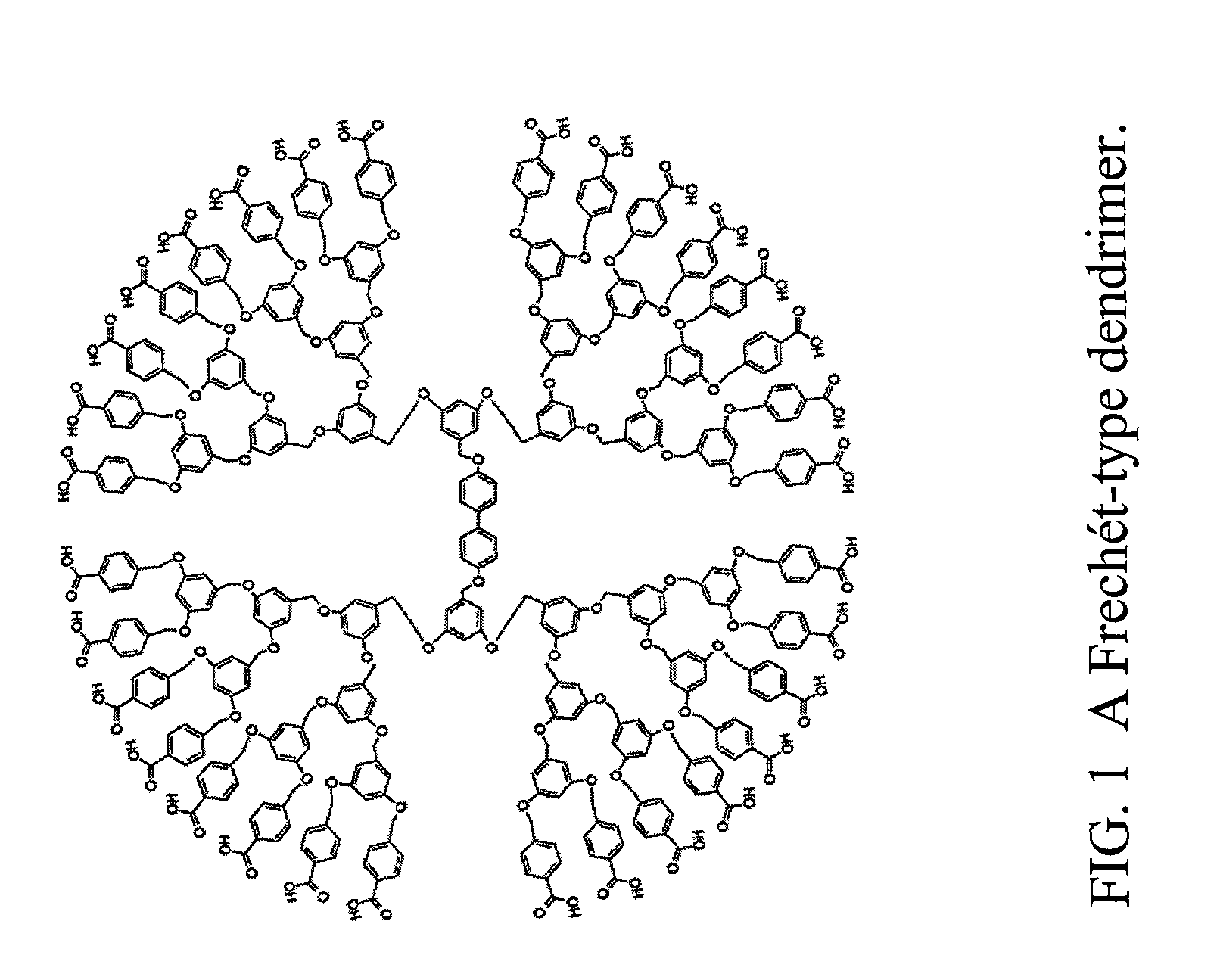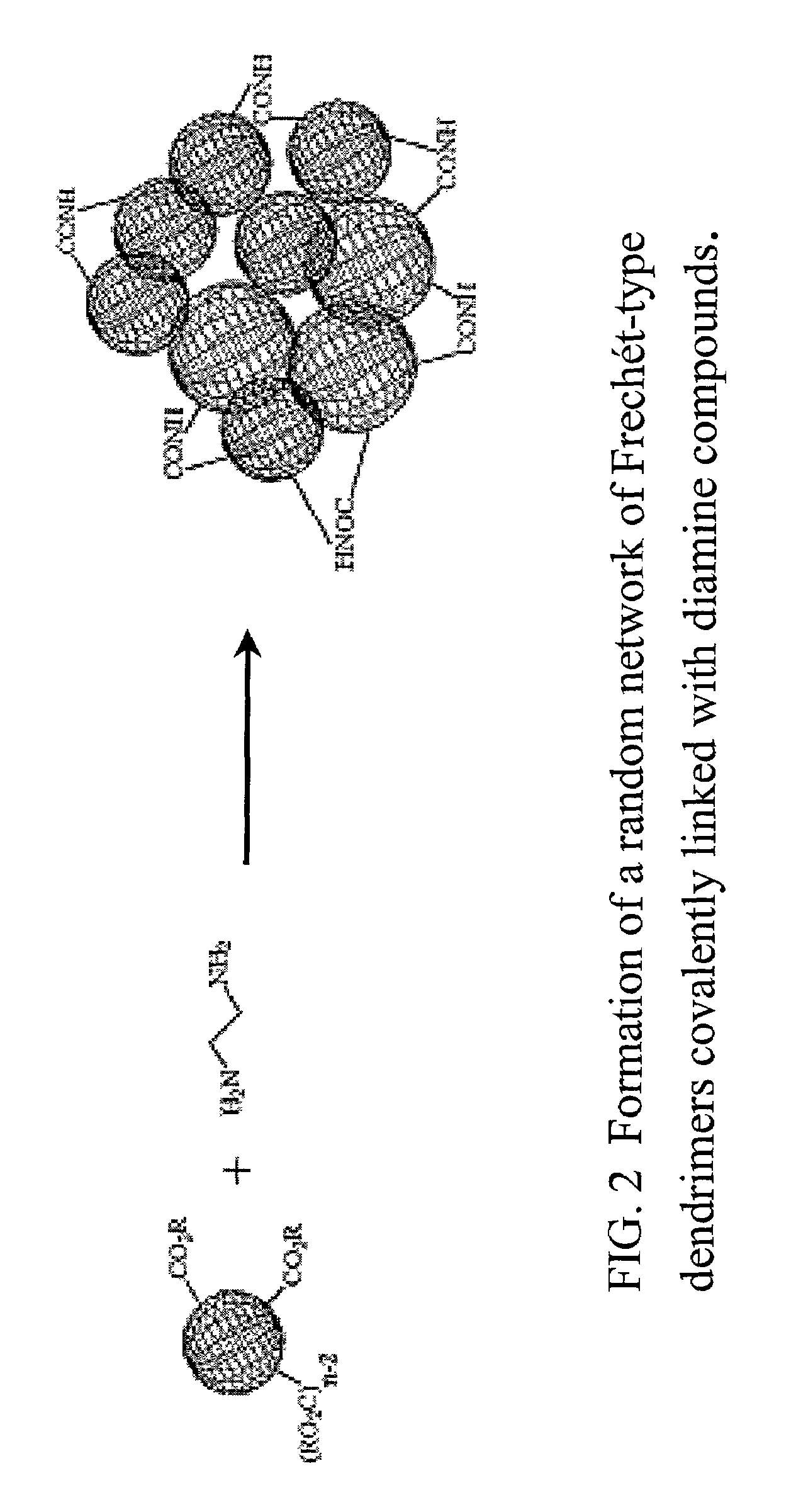Proton conducting membrane for fuel cells
a fuel cell and conducting membrane technology, applied in the direction of conductive materials, electrical equipment, chemical/physical processes, etc., can solve the problems of reducing the ionic conductivity of fuel cells, reducing and subsequent loss of mechanical strength, so as to reduce the crossover rate and reduce the methanol crossover rate. , the effect of limiting the water content in the pores
- Summary
- Abstract
- Description
- Claims
- Application Information
AI Technical Summary
Benefits of technology
Problems solved by technology
Method used
Image
Examples
example 1
Production of a Membrane Made from Diamine-linked Frechét-type Dendrimers
[0037]Frechét-type dendrimers are formed as described by Hawker et al. in J. Chem. Soc. Perkin Trans. 1, 1287 (1993). Such dendrimers are formed by reacting two equivalents of methyl-p-bromomethylbenzoate with 3,5-dihydroxybenzyl alcohol in the presence of 18-crown-6 and potassium carbonate in refluxing tetrahydrofuran (THF). The resulting first generation (G1) alcohol is converted to the bromide in an 83 percent yield by reaction with carbon tetrabromide / triphenylphosphine. Reaction of two equivalents of this bromide with 3,5-dihydroxybenzyl alcohol leads to the second generation dendrimer in a 91 percent yield. These steps are repeated to get to generation 3, then generation 4 dendrimers in yields of about 85 percent. At generation 4, two equivalents of brominated generation 4 dendrimer are reacted with 4,4′-dihydroxy biphenyl in refluxing THF to provide a [G4]-O—C6H5—O-[G4] macromolecule in an 81 percent yie...
example 2
Production of a Membrane Made from Diamine Linked Frechét-type Dendrimers
[0040]Frechét-type dendrimers are formed as described by Forier, et al., in Tetrahedron 55, 9829 (1999), which is herein incorporated by reference. Such dendrimers are formed by adding 6.9 grams of methanesulphonyl chloride to 4.8 grams of a G1 alcohol, which is produced as described in Example 1 above, and 7.6 grams of triethyl amine in 50 ml of dry dichloromethane at −10° C. under a nitrogen atmosphere. The mixture is stirred for one hour then poured over a mixture of 100 ml of crushed ice and 10 ml of concentrated hydrochloric acid (HCl). The organic layer is then separated, washed with an NaHCO3 solution, dried over MgSO4, and evaporated. The product is recrystallized from diethyl ether to give a [G1]-OSO2CH3 product at an 87 percent yield.
[0041]Higher generation dendrimers are prepared in a similar manner. Specifically, the G2 alcohol is prepared from the [G1]-OSO2CH3 product by refluxing in an acetone sol...
PUM
| Property | Measurement | Unit |
|---|---|---|
| temperatures | aaaaa | aaaaa |
| temperatures | aaaaa | aaaaa |
| temperature | aaaaa | aaaaa |
Abstract
Description
Claims
Application Information
 Login to View More
Login to View More - R&D
- Intellectual Property
- Life Sciences
- Materials
- Tech Scout
- Unparalleled Data Quality
- Higher Quality Content
- 60% Fewer Hallucinations
Browse by: Latest US Patents, China's latest patents, Technical Efficacy Thesaurus, Application Domain, Technology Topic, Popular Technical Reports.
© 2025 PatSnap. All rights reserved.Legal|Privacy policy|Modern Slavery Act Transparency Statement|Sitemap|About US| Contact US: help@patsnap.com



